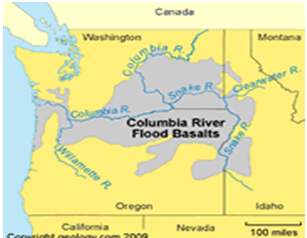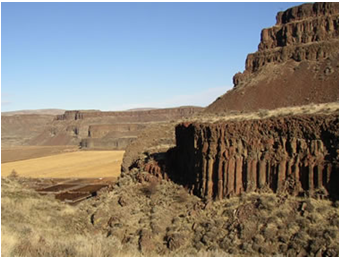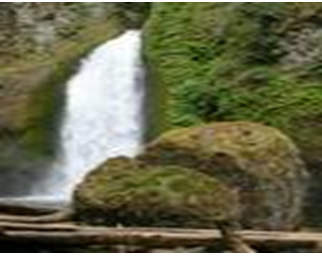Columbia River has been providing the surrounding human beings with salmon for a long period. In the beginning, a remarkably healthy relationship between this natural feature, and the people surrounding it was very healthy and productive.
The people used to treat all natural features with respect, as thy also benefited from them. It was the responsibility of everyone to protect rivers and other features. On the other hand, natural features used to provide enough sustainability to humankind.
Everyone would wish this mutual relationship to last forever. Before the arrival of non-Indians, the land and water bodies were rich and very productive.
The people who lived around this basin relied on salmon, as part of their religion and culture. The society had a culture of honoring salmon, as they served them with plenty food, and surplus to trade with in other regions (Roe 117).

The above chart shows the positioning of Columbia River in Washington Oregon, and Idaho (Columbiariver.com).
The culture of the people around the river connected Columbia River both spiritually and physically. This was made possible through salmon providing humankind with the necessary energy to move on with life.
On the other hand, Native Americans made efforts to experience and learn more about the great river. The cultures of these people taught them that salmon as part of smolts they used to go to pacific for some food and a chance to grow (Cox 307).
However, the changes in temperature and other forces in the pacific, failed to favor the life of salmon, making them go back to their streambeds for reproduction and death. According to the beliefs of the Native Americans, salmon were coming back through spiritual forces, as they were less expected back.
When salmon got back in Columbia River, it turned as a great joy to these people, as they considered this as their harvesting season. They took this issue as a gift, as they were never involved in either planting or growth of salmon. Their work was only harvesting.
The history of the area provides evidence that Coyote used to advise the Indians on how to cook salmon properly. Coyote also shaped the big rocks at the falls, so that people would use them to catch fish.
According to one historian named Richard White the technologies that were initiated by indigenous humans as one of natural technologies of the Columbia (Cox 118). It was the culture of these people for men to work hard in hunting the fish, and women to preserve them.
The major method, which was used to preserve these fishes were by smoking, to make them available during the fluctuations.
This region also provided humans with enough sun energy that would dry those fishes. Most Indians proffered drying their fish with sun energy, unlike the Native Americans who used to smoke.
Nevertheless, the relationship of Columbia River and the people surrounding it started changing slowly. For the last 150 years, several wasteful and disrespectful practices affected the river, and other natural features around the area.
These activities marked the onset of conflict among the people who solely depended on these natural resources. The natural resources were destroyed, due to lack of adhering to the treaty that was made in 1855 (Hall 23).
Lack of good human management of the Columbia River and ocean resulted to destruction of the natural resources. The people around the region discovered that things are getting out of their hands, when they realized some species are disappearing.
Several attempts of fighting back for the productivity of Columbia River were made by these people. It was evident that, salmons have been the sole source of sustenance of people within the locality. Some people used salmon when offering religion gifts, as well as played as a great part of their culture.
Geology of Columbia River
The formation of Columbia River is estimated to have started approximately between 12 and 17 million years ago. This period is dated back to the Miocene. Approximately between 700000 and 2million years ago, is when the Columbia River started taking its current shape (Roe 98).
Geologists date this period with Pleistocene, when the activities of forming cascades ranges were ongoing. In addition, the formation activities of cascades ranges resulted to the mechanical movement of Columbia rivers delta, towards the north side of its current position.

The above figure shows the Columbia River flood basalts leaving organic rocks exposed (geology.com).
For a period, the Columbia River slowly eroded the surrounding land. Geologists considered some of those activities as minor, while others were significant to be noted.
For instance, there was a great impact of the river towards the end of the final ice age. During this period, the river flooded, the steeps were destroyed, leading to strong walls that exist today along the river (Cox 312).
Severally, the Columbia River caused strange and strong floods, some going as high as Crown Point. To some extent, the flooding resulted to quick soil erosions to the nearby land, leaving large layers of rocks exposed.
Fresh water
The Columbia River is a fresh water system, surrounded with green trees such as big leaf maple and vine maple. The various precipitation within this area results to different types of ecosystems.
The major feature that contributes to increment of fresh water in this river is the availability of temperate rainforest wit average annual rain of 1900mm. Other important natural resources that contribute to the existence of fresh waters are the waterfalls.
The area has more than 90 waterfalls, with some as high as 190m high. Much of the Columbia water flows into Pacific Ocean. It is considered as the most dominant water system in that region. It has been estimated that approximately 15million people rely on the presence of fresh water from this river (Roe 106).
People’s several activities like transportation, fishing and industrial water rely on the Columbia fresh water. Globally, this is the highly utilized river in hydro electrification generation. The hydropower is generated from this river through the establishment of more than 400 dams.
The Columbia ice fields are the relied source of water for Columbia River. Among all economic activities supported by the river fresh water, the most crucial for people surrounding it is fishing.

The above figure shows the flow of Columbia River fresh water flow (geology.com).
There was a time, when people around the basin decided to look for a permanent solution, to save their natural resource. These people could not let the natural provision of fresh water to be destroyed.
They searched for ways of saving salmon and its entire species, as a way of sustaining themselves and boosting the economy in the area. The plan was meant to be their solution, to safeguard the future of their grandchildren, and many generations to come (Cox 216).
The efforts of humankind to save the productivity of Columbia River received some religion support from “catholic bishops of Columbia river watershed”. The religion forum suggested that the values that these people will express, the objectives that they will raise, and their insights would dictate the direction of solving the issue.
The main theme of restoring and solving the complex issues of Columbia River was that it entailed the spiritual, social, and cultural lives of the people around the basin.
Works Cited
Cox, Ross. The columbia River: Adventures during a residence of six years. New York: Biblio Bazaar, 2010.
Hall, Stewart. The columbia River. New York: Holt Rinehart and Winston, 2007.
Roe, JoAnn. The Columbia River: A historical travel guide. Michigan: Fulcrum Pub, 2004.